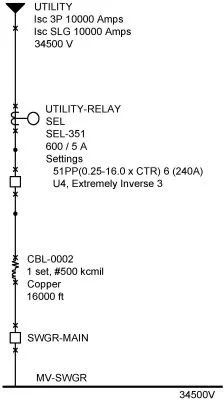How an Updated Arc Flash Risk Assessment Will Improve Safety for your Electrical Personnel
/NFPA 70E states that an Arc Flash Risk Assessment should be updated every five years or when significant electrical system changes occur. How important is this? Even if all equipment within your electrical distribution system has remained the same, it is still essential to perform an updated risk assessment based on possible changes undertaken outside of your system. This article explores the arc flash impacts to an electrical system based on changes performed by others (i.e. the utility company) — specifically pertaining to the available utility fault currents and/or the utility protection system.
Low Voltage System – Change in Utility Fault Current
This example considers a change in the utility fault current contribution for a low voltage commercial customer. It analyzes the impact at the customer’s low voltage switchboard that is supplied by a utility source (via a utility transformer) with an available primary fault current of 10,000A. The utility transformer, rated 1000kVA, is protected by a 65A expulsion fuse and is located 50 feet upstream of the customer’s 480V service-entrance switchboard. See figure below for depiction.
For this system configuration, the arc flash incident energy is 14.2 cal/cm2 at the “line side” of the customer’s switchboard. If the utility company were to expand their grid capacity and their fault current contribution increased to 30,000A, the incident energy at the customer’s switchboard would decrease to 13.3 cal/cm2. The lower incident energy is due to the larger fault current and the corresponding faster clearing time of the protective fuse. By performing an updated Arc Flash Risk Assessment, such a change can be promptly recognized. This example portrays a specific case where an increase in the utility fault current contribution can actually lower the arc flash incident energy at downstream electrical equipment.
Medium Voltage System – Change in Utility Fault Current
This example considers a change in the utility fault current contribution for a medium voltage industrial customer. It analyzes the impact at a customer’s medium voltage switchgear that is supplied by a utility source with an available primary fault current of 10,000A. The utility supply feeder is protected at the utility substation by a multifunction relay, which is located approximately 3 miles upstream of the customer’s 34.5kV service entrance switchgear. See figure below for depiction.
For this system configuration, the arc flash incident energy is 35.8 cal/cm2 at the “line side” of the customer’s switchgear. If the utility company were to expand their grid capacity and their fault current contribution was increased to 17,000A, the incident energy at the customer’s switchgear increases to 50.9 cal/cm2. By performing an updated Arc Flash Risk Assessment, such a change can be promptly recognized, and PPE requirements adjusted as appropriate to improve personnel safety.
Medium Voltage System – Change in Utility Protection System
This example considers a change in the utility protection scheme for the same medium voltage industrial customer (see figure above). For this system configuration, the arc flash incident energy is still 35.8 cal/cm2 at the “line side” of the customer’s switchgear. If the utility company were to expand their grid capacity and adjust their utility feeder protective device settings to meet increased demand, the incident energy at the customer’s switchgear increases to 44.7 cal/cm2. Again, by performing an updated Arc Flash Risk Assessment, such a change can be promptly recognized, and PPE requirements adjusted as appropriate to improve personnel safety.
The Case for an Updated Arc Flash Risk Assessment
Utility companies frequently adjust and expand their grid operations to meet increased customer demand. Such adjustments are necessary since the utility company’s primary responsibility is to ensure the supply of reliable power to all customers. This causes in changes to the utility fault current contributions and the utility protection system. Such aspects require performing an updated Arc Flash Risk Assessment at customer facilities even if the electrical distribution system within a customer’s facility has not changed. Such utility system changes can happen outside of your sphere of control, but yet could result in significant changes to the arc flash safety aspects within your facility.
Up-to-date power system studies must be performed to keep your electrical personnel safe. Contact us for recommendations to suit your specific electrical safety requirements or if you need help interpreting OSHA, NEC, NFPA 70E, and IEEE 1584. For a free consultation on how you can perform an updated Arc Flash Risk Assessment, call us at (240) 582-3900 or email us at info@helioselectric.net.
To learn about our other unique solutions that can enhance your electrical facilities, click here.





